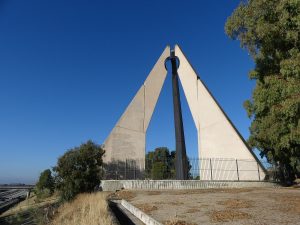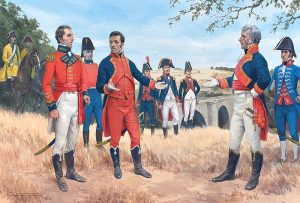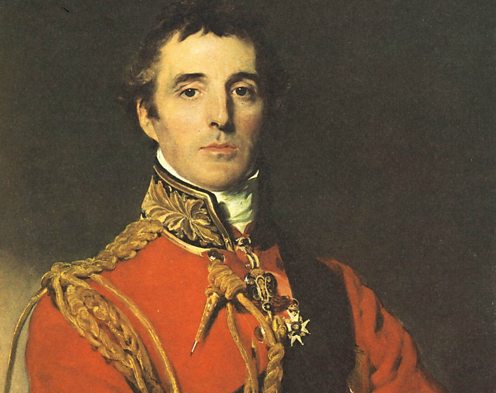 The Battle of Talavera was fought on this day in 1809 near the town of Talavera de la Reina in Spain. Sir Arthur Wellesley, fresh from his highly efficient victory at Oporto took 20,000 British troops into Spain to join General Cuesta’s 33,000 Spanish troops. They marched up the Tagus valley to meet a French army some 46,000 strong, officially commanded by Joseph Bonaparte but actually under the command of Marshal Victor and General Sebastiani.
The Battle of Talavera was fought on this day in 1809 near the town of Talavera de la Reina in Spain. Sir Arthur Wellesley, fresh from his highly efficient victory at Oporto took 20,000 British troops into Spain to join General Cuesta’s 33,000 Spanish troops. They marched up the Tagus valley to meet a French army some 46,000 strong, officially commanded by Joseph Bonaparte but actually under the command of Marshal Victor and General Sebastiani.
 Wellesley did not do well in his attempts to cooperate with Cuesta. Not for the first time, the British army found that their Spanish allies were unable to come up with the supplies and transport they had promised. It is not clear whether this was negligence, inefficiency or simply that the supplies were not available, but it left Wellesley’s army in a difficult position with food running out. In his negotiations with Cuesta, there was a language difficulty as Wellesley did not speak Spanish and Cuesta spoke little English and refused to speak French. It is possible there was also a simple clash of culture as Wellesley fumed at what he perceived as inactivity and poor planning on the part of the Spanish.
Wellesley did not do well in his attempts to cooperate with Cuesta. Not for the first time, the British army found that their Spanish allies were unable to come up with the supplies and transport they had promised. It is not clear whether this was negligence, inefficiency or simply that the supplies were not available, but it left Wellesley’s army in a difficult position with food running out. In his negotiations with Cuesta, there was a language difficulty as Wellesley did not speak Spanish and Cuesta spoke little English and refused to speak French. It is possible there was also a simple clash of culture as Wellesley fumed at what he perceived as inactivity and poor planning on the part of the Spanish.
Nevertheless, some agreement was reached and after days of delay and misunderstanding there was a clash between the French and British armies on 27th July which led to 400 casualties in Donkin’s brigade. To add to Wellesley’s mistrust of his Spanish allies there was a farcical episode during the evening of the 27th when Cuesta’s men fired a volley without orders at some French dragoons. Little damage was done to the French but four Spanish battalions dropped their weapons and fled in panic. Afterwards Wellesley wrote:
“Nearly 2,000 ran off on the evening of the 27th…(not 100 yards from where I was standing) who were neither attacked, nor threatened with an attack, and who were frightened by the noise of their own fire; they left their arms and accoutrements on the ground, their officers went with them, and they… plundered the baggage of the British army which had been sent to the rear.”
Cuesta, deeply embarrassed, sent cavalry to bring the troops back but it did nothing to improve relations between the British and the Spanish.
During the night, Marshal Victor sent three regiments up the hill known as the Cerro de Medellin. Two of them got lost in the dark but the third managed to surprise a brigade of the King’s German Legion which had gone to sleep, apparently believing that they were the second line instead of the first. In a chaotic action in the darkness on the hilltop, General Rowland Hill sent in Stewart’s brigade from the second division to recapture the ground and the French retreated.
At dawn the French artillery began firing, and Wellesley was obliged to pull his men back into cover to avoid major casualties. Ruffin’s division attacked the Cerro de Medellin again in column but the British emerged from cover in line and the French were broken by musket volleys and ran.
After an informal truce when dead and wounded were removed and the French leaders consulted Joseph Bonaparte, a frontal attack was launched against the British 1st and 4th divisions, once again in column. They were routed by the Guards brigade but the Guards pursued too far and ran into the French second line, losing 500 men to artillery fire. Wellesley realised that his centre was broken and brought up the 48th foot to fill the gap in his lines. Mackenzie’s brigade joined them and the French attack was pushed back again, with Lapisse mortally wounded.
In the fictional version of the battle, described in An Unconventional Officer, Major Paul van Daan’s battalion of the 110th fought as part of Hill’s division and were involved in the night battle on the Cerro de Medellin and then in the centre battle. Several field hospitals were set up in and around the town of Talavera, some of them using convents and monasteries and it is in one of these that Anne Carlyon worked as a volunteer alongside Dr Adam Norris as the wounded were brought in.
With his main attack defeated, Victor sent Ruffin’s men into the valley between the Medellin and the Segurilla. Anson’s cavalry brigade was sent to push them back but an undisciplined charge by the 23rd light dragoons ended in disaster in a hidden ravine. The French had formed squares and fought off those cavalry which had managed to negotiate the hazard with considerable losses among the British and Germans.
It was the last French attack of the day. Joseph and Jourdan chose not to send in their reserve and during the night the French melted away leaving behind 7389 dead, wounded and captured soldiers. Allied losses were worse over the two days with the British losing 6268 dead and wounded and the Spanish 1200. Wellesley lost approximately 25% of his forces and in a final horror, wounded men from both sides burned to death when the dry grass of the battlefield caught fire.
Meanwhile, Marshal Soult was moving south, in an attempt to cut Wellesley off from Portugal. Wellesley initially believed that Soult’s had only 15,000 men and moved east to block it but Spanish guerrillas intercepted a message from Soult to Joseph confirming that Soult had 30,000 men. Fearing that his line of retreat was about to be cut by a larger French force, Wellesley sent the newly arrived Light Brigade on a mad dash for the bridge at Almaraz. Craufurd’s men arrived just ahead of Soult and Wellesley withdrew his army across the mountains and organised his defence of Portugal. His hard fought victory brought him the title of Viscount Wellington of Talavera.
Historians disagree about Wellesley’s problems with the Spanish. Some consider the campaign a failure despite the victory and cite the failure of the Spanish to supply Wellesley’s army as the reason. Wellesley certainly believed that the Spanish made promises which they failed to keep. However, the condition of Spain at that time may well have made it impossible to provide the necessary food and transport and the personal difficulties between Cuesta and Wellesley certainly did not help. There were also political rumblings, with suggestions that Wellesley might be given control of the Spanish army and Cuesta was undoubtedly upset by the idea although it does not seem that it originated from Wellesley himself. Wellesley was cautious from the start about his Spanish adventure, citing the fate of Sir John Moore’s army during the campaign of 1808 and his determination not to allow his route back to Portugal to be cut off made him wary.
On the whole, it was probably not the time for an all out invasion of French-controlled Spain. Wellesley’s original brief had been to defend Portugal but his army was not yet the formidable fighting force which he later led to victory at Salamanca and Vitoria. The severity of his losses made his retreat a sensible choice and the time he spent consolidating in Portugal put him in a far better position to resume the campaign.

